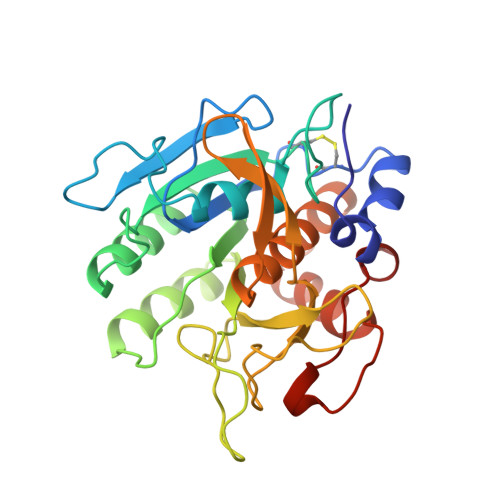Large increases in general stability for subtilisin BPN' through incremental changes in the free energy of unfolding.
Pantoliano, M.W., Whitlow, M., Wood, J.F., Dodd, S.W., Hardman, K.D., Rollence, M.L., Bryan, P.N.(1989) Biochemistry 28: 7205-7213
- PubMed: 2684274
- DOI: https://doi.org/10.1021/bi00444a012
- Primary Citation of Related Structures:
1A2Q, 1AK9, 1AU9, 1S01 - PubMed Abstract:
Six individual amino acid substitutions at separate positions in the tertiary structure of subtilisin BPN' (EC 3.4.21.14) were found to increase the stability of this enzyme, as judged by differential scanning calorimetry and decreased rates of thermal inactivation. These stabilizing changes, N218S, G169A, Y217K, M50F, Q206C, and N76D, were discovered through the use of five different investigative approaches: (1) random mutagenesis; (2) design of buried hydrophobic side groups; (3) design of electrostatic interactions at Ca2+ binding sites; (4) sequence homology consensus; and (5) serendipity. Individually, the six amino acid substitutions increase the delta G of unfolding between 0.3 and 1.3 kcal/mol at 58.5 degrees C. The combination of these six individual stabilizing mutations together into one subtilisin BPN' molecule was found to result in approximately independent and additive increases in the delta G of unfolding to give a net increase of 3.8 kcal/mol (58.5 degrees C). Thermodynamic stability was also shown to be related to resistance to irreversible inactivation, which included elevated temperatures (65 degrees C) or extreme alkalinity (pH 12.0). Under these denaturing conditions, the rate of inactivation of the combination variant is approximately 300 times slower than that of the wild-type subtilisin BPN'. A comparison of the 1.8-A-resolution crystal structures of mutant and wild-type enzymes revealed only independent and localized structural changes around the site of the amino acid side group substitutions.(ABSTRACT TRUNCATED AT 250 WORDS)
Organizational Affiliation:
Genex Corporation, Gaithersburg, Maryland 20877.

















